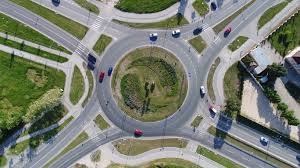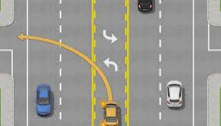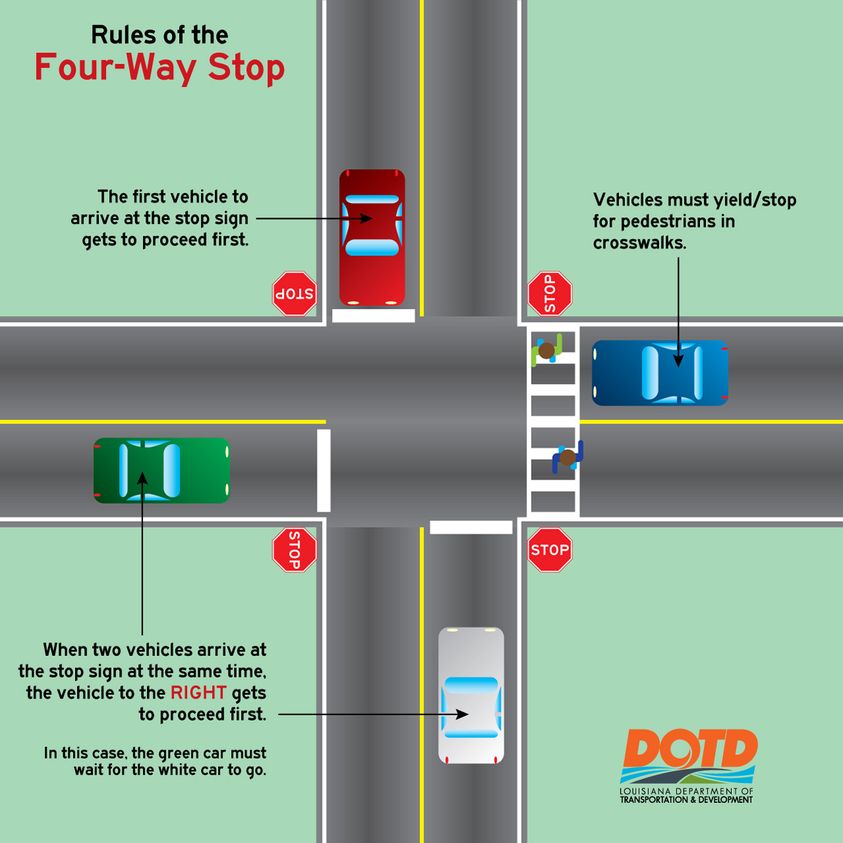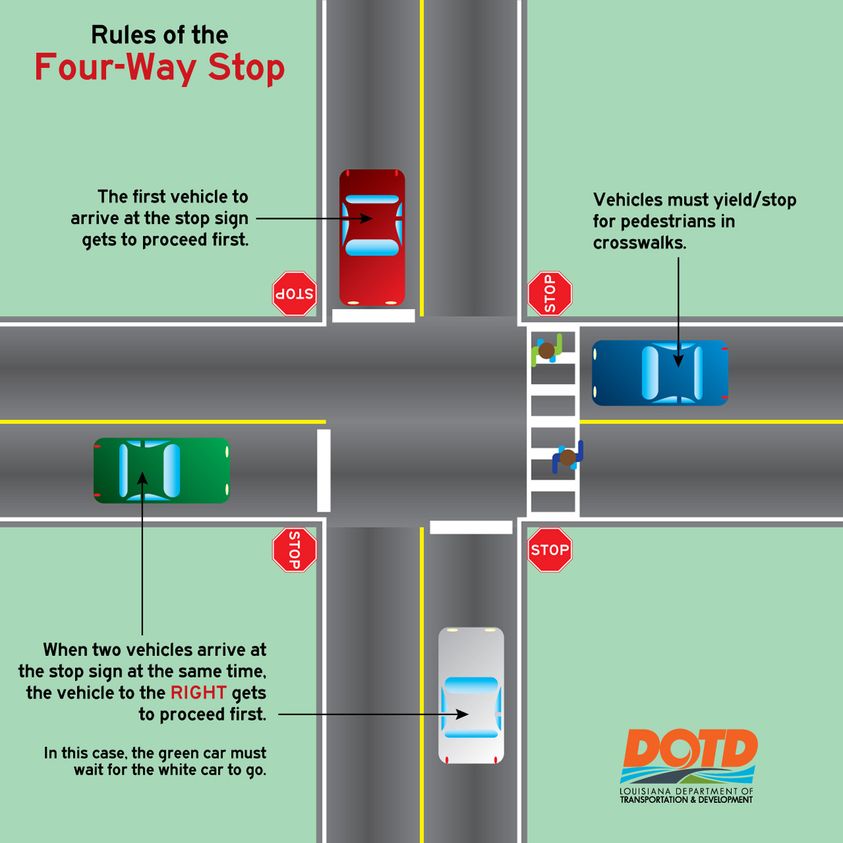
Don’t Get Turned Around in A Roundabout
Roundabouts are also called traffic circles. Roundabouts are one-way, circular intersections designed to improve safety and efficiency for motorists, bicyclists, and pedestrians. In a roundabout, traffic flows counterclockwise around a center island. A roundabout redirects some of the conflicting traffic, such as left turns, which cause crashes at traditional intersections. This is because drivers enter and exit the roundabout through a series of right-hand turns.
Roundabouts replace regular intersections. They do not have stop signs, which eliminates the cost of electric traffic signals. Drivers must yield when entering and exiting a roundabout and must travel in a counterclockwise direction. Greater safety is achieved primarily by slower speeds and the elimination of more severe crashes and operation is improved by smooth-flowing traffic with less stop-and-go than a signalized intersection. Aesthetics are enhanced by the opportunity for more landscaping and less pavement, according to the DOTD. Roundabouts were first introduced in the U.S. in the 1990s. And since September 2003, some 174 more have been built in Louisiana according to the DOTD.
While intended to improve traffic flows and increase safety, roundabouts do not eliminate all traffic crashes. Many of the roundabout crashes are caused by drivers who are unfamiliar with them and the traffic rules that govern them. It is important to know that roundabouts may have two or more lanes, so know which lane you need before you enter the traffic circle.
Common Reasons for Crashes At Roundabouts
- Failure to yield to traffic that is already in the circle.
- Failure to yield to bicyclists and pedestrians.
- Drivers who stop abruptly in the circle because they are confused or missed their turn.
- Speeding when entering the circle.
Preventing Roundabouts Crashes
You cannot control the actions of other drivers. But if you obey some basic rules for roundabouts, you can help prevent a wreck:
- Slow down as you approach a roundabout.
- Yield to traffic that is already in the roundabout.
- Use your turn signal when exiting the roundabout.
- Give trucks and larger vehicles enough space to maneuver and exit the roundabout.
- Do not stop once you are in the traffic circle.
- Know which exit you need to take before you enter the circle.
Roundabout Crash Legal Timeline
Under Louisiana law, an crash victim has one year from the date of injury to file a lawsuit or, if possible, settle the case. When this one-year period expires, the crash victim loses the right to sue the wrongdoer for both economic and non-economic damages.
If You Need An Experienced Attorney
Call us today. We have been helping those injured for over 50 years. We work for our clients, explaining the laws that protect them, the laws that were broken, understanding the facts and our client’s injuries and how those injuries have impacted their daily lives, their goals, and their dreams. So, if you need a great lawyer, call us at (337) 232-1934 to get started.

A Quick Summary of Louisiana Auto Insurance
Here is a quick summary of car insurance in Louisiana.

Are you using a center turn lane wrong
CENTER TURN LANE
Some two-way streets have a center turn lane, which makes it easier for vehicles to either turn or move into one of the travel lanes. The center turn lane is located between lanes of opposing traffic and is bounded on each side by one solid yellow line and sometimes times by a broken yellow line. These lines mean that the center lane is not a travel lane. A motorist may turn into it briefly while looking to either merge with the traffic or turn left onto another street.
The Louisiana Driver’s Guide “D” and “E” states, in part, that “There is something called two-way left turn channelization markings, and they are combinations of solid yellow and dashed yellow lines that are in the center of the roadway. The designated center lane, a center lane that is designated in this way may be used by vehicles traveling in either direction for left turn maneuvers only and this lane must never be used for passing.”
A motorist who wants to turn left from the center lane must activate the vehicle’s left turn signal and then wait until there is a large enough gap between the vehicle and oncoming traffic before turning left or merging into a regular lane. If a motorist wants to merge into traffic on the right, a right turn signal must be activated and, when there is an adequate gap in the traffic, only then can the motorist move.
A motorist may not drive a vehicle in the center turn lane for more than 200 feet while waiting to turn left or merge into the adjacent travel lanes or to reach a dedicated left-turn lane at an intersection. A vehicle in a dedicated left-turn lane at an intersection shall turn at the intersection only as designated by posted pavement marking, signing, or traffic signal indication.
You May Need A Lawyer To Recover Your Damages
Under Louisiana law, an accident victim has one year from the date of injury to file a lawsuit or, if possible, settle the case. When this one-year period expires, the accident victim loses the right to sue the wrongdoer for both economic and non-economic damages.

4-Way Intersections: Who Goes First?
Do you know what to do when you get to a 4-way intersection? Generally, they are marked with a Stop Sign for each approaching vehicle. The Stop Signs take the place of an electric control light. Motorists often get confused at these intersections. BEWARE! Many motorists don’t know the simple rules that apply to 4-way intersections or they just disobey them. Motorists often get confused at these intersections, but the rules are really quite simple.
Here are FOUR SIMPLE RULES:
Rule 1: First to arrive, first to drive. When you’re approaching a 4-way stop, drivers who stopped before you have the right of way. If two or more vehicles reach the intersection at the same time, the driver on the left must yield to the driver on your right.
Rule 2: Right-of-way goes to the right, so if two vehicles arrive at the same time, stop, and the car on the right has the right-of-way.
Rule 3: Straight doesn’t have to wait. If 2 vehicles arrive at the same time and are across from each other, stop and watch in which direction the other vehicle is going. If it goes straight, it’s safe for you to go straight because you won’t cross each other’s path. If you are turning, then the car that is going straight has the right-of-way.
Rule 4: Left turn yields to the right. If two vehicles arrive directly across from each other at the same time and both are turning, then the vehicle that is turning left yields to the one that is turning right. These are COMMON SENSE rules. Know them, follow them, and you’ll be safe.

